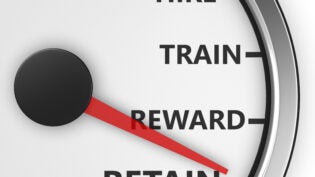
Developing loyal customers begins with developing a team who understand the importance of customer-focused service and care about the total customer experience.
A key building block of developing high performance employees is recognizing the behaviors that you want repeated—those that ultimately create loyalty with your customer.
Employees who receive regular recognition are happier in their jobs, they stay with the company longer, and they are more productive. Ultimately, recognizing employees encourages them to provide superior service because their attitudes about their workplace are improved.
Recognition is the ultimate performance excelerator.
- Identify the appropriate level and type of recognition that individual employee’s value. Before you decide on how to recognize desired behaviors, you first need to realize that not all employees are motivated by the same things. Importantly, employee recognition need not be extravagant or expensive—recognition is a much broader activity than reward, which is simply one aspect of recognition.
- Knowing when to recognize an employee is as important as knowing how. There are times when recognizing an entire team is most valuable and other times recognition will work best when given individually. Too much group recognition leads high-performers to lower their performance to the lowest common denominator since low performers get the same recognition anyway. The ideal is to blend the 2 types based on your specific situation and team.
- Timing is everything. In every case, timeliness is critical. Recognition long after the event has occurred loses all value. The time after the event should reflect the event. If it is for a specific behavior, it should be within 24 hours. However, if the recognition is for a longer term initiative it can be sometime after the event—for example at a formal presentation.
- Use a variety of recognition techniques. Like timing, recognition must be aligned with the behavior being recognized. Make sure the significance of the recognition reflects the activity being recognized. A heartfelt thank you for handling a difficult customer or staying to finish a project one night might be exactly right, but would be woefully inadequate if someone stayed late for 2 weeks in a row to get a special assignment completed. If everything sounds the same, it doesn’t feel sincere and over time your program will lose its effectiveness.
- Consider a company picnic, retreat, catered dinner, seasonal party, or other social event. Spend time in conversation, laughing, talking with employees and just having fun. Get to know a little bit about each person—use this time to better understand what motivates each person. One of the most powerful forms of recognition is letting employees know that leadership is concerned about them as individuals, not simply workers. A great lead-in question is “What do they like to do during their time off?”
- Money is not the ultimate motivator, but cash is still a good incentive. A cash bonus, a gift card, or a pay raise often work well as employee recognition. However, consider other, non-monetary options — possibly a day off with pay or more flexible work time to allow for more family time.
- Offer opportunities to improve skills and utilize new knowledge. Seminars, workshops and other specialized training are powerful motivators to high performing employees who are interested in improving their performance and expertise. Follow this up with the opportunity to apply these new skills in a useful way for the organization.
- Provide software upgrades and enhanced tools and equipment. A better computer, an updated phone system, or even a coffee pot with added features let employees know you understand their need for a quality work environment.
- Throw a little competition into the mix by holding employee performance contests. Increased sales, customer recommendations or other monitors can create a fun, yet competitive atmosphere for recognizing excellence and achievement.
- Show appreciation to employees in front of their peers—where it matters most. Some employees are impacted most by public recognition. For them, consider a trophy or plaque with their name imprinted on it, or a story about them in the company newsletter. Be aware, some employees may find this public display very uncomfortable, so make sure you are sensitive to these feelings when providing public accolades.
- Highlight the team member who shows the best job performance. Create an “Employee of the Month”. Even something as simple as a certificate or a parking place near the door can motivate performance. Post their photos and names on the employee bulletin board, or announce their achievements over the PA system. This also provides a great opportunity to reinforce the desired behaviors as part of the presentation to the employee that wins each month.
- Say thank you. Often these two little words mean more when creating loyal employees than anything else you can do. Use them often and let your team members know you value their efforts.
- Start slow. If this isn’t usual behavior or if recognition is currently an under-utilized technique, a sudden change will raise eyebrows and potential suspicion. So build up. Make a personal commitment to start with a small moment of recognition daily and build from there. Employees will see this as more genuine and will recognize you for your efforts to make a personal change in behavior. And commit to the long term, otherwise a sudden burst will increase cynicism for any future initiative.
- Ask your employees for their input. Leverage their creativity about what type of program they would find most meaningful to establish a recognition program that works best for them.
- Make sure you recognize desired behaviors. Don’t simply have a recognition program for anything that goes well. Every time you provide recognition make sure it is linked to a specific value, principle or behavior that you want to see repeated.
By implementing these and other ideas, you let your team know how grateful you are for their contribution. You will develop a loyal team who feel appreciated and important. Such an effort is guaranteed to enhance your customer service.












